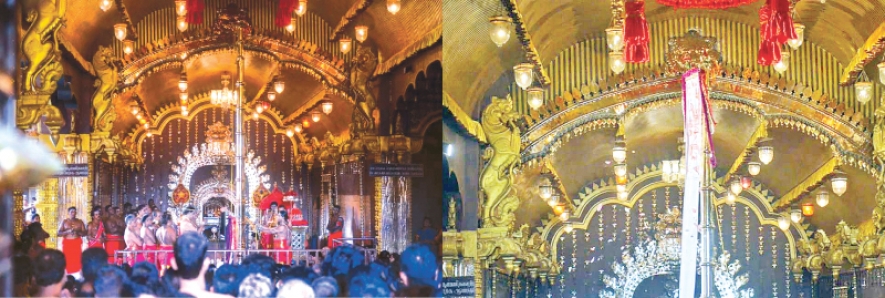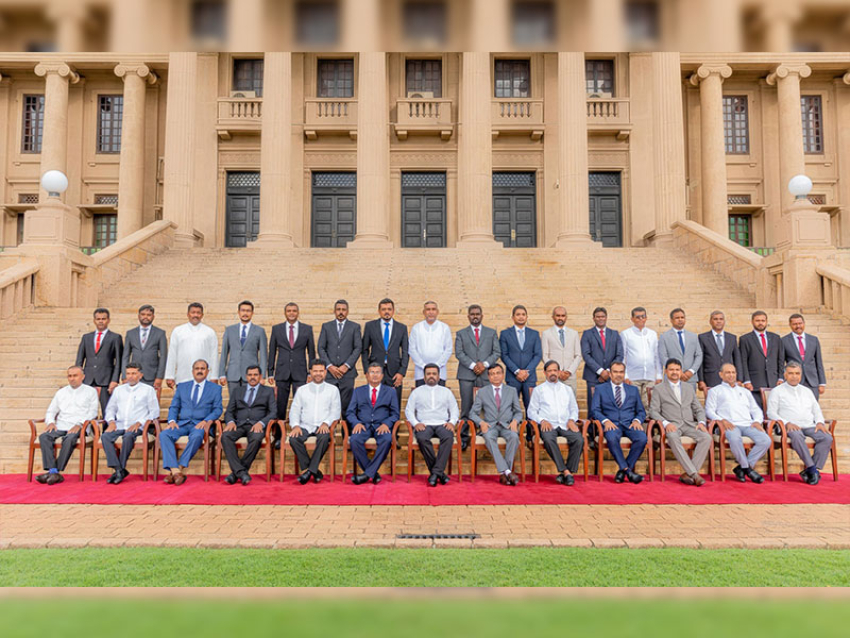The Nallur Kandaswamy Kovil which is also known as the Nallur Murugan Kovil is one of the most famous Hindu temples in the Jaffna peninsula. It is situated in the Nallur town and the Nallur Kovil festival is one of the longest festivals which usually runs for about 25 days. During these 25 days, Jaffna is filled with people from far and wide and many Tamil expatriates come to Sri Lanka to pay their various vows and take part in the festival rituals. This colourful festival includes vibrant chariot processions, rhythmic drumming, dancing and acts of self-mortification, mainly devoted to god Skanda.
This year the Nallur festival started on August 16 and this annual festival will ceremonially end on September 9. Thousands of devotees will attend the daily Pooja ceremonies in the morning and in the evenings.
During the annual festival, thousands of Tamil Hindu devotees attend the Nallur temple rituals in worship of Lord Murugan, Valli and Devanai Ammn. Specially made and colourfully decorated chariots and traditional “Vaganangal” is used for the transportation of the Gods. The devotees perform all sorts of devotional rituals to show their devotion to the gods from pulling the chariot to rolling on the bare ground seeking the blessings of the gods. Others line up on the chariot route to get a glimpse of the processions. During this procession, the entire area is a sea of people with barely a space to move.
This annual 25-day festival is generally celebrated continuously every year following the Aadi Amavasai day. The procession commences inside the kovil and eventually winds its way to the outskirts.
Sacred Flag hoisting ceremony
The twenty-five day annual festival of the historic Nallur Kandasamy Temple in Jaffna began on Thursday, August 16 with the Sacred Flag hoisting ceremony (KodiYetam) in the presence of a large number of devotees. The chariot (THER) festival will be held on September 8 and the Water Cutting (Theertham) festival on September 9, temple authorities said. The festival symbolises the precepts of the Saiva doctrine which is a collection of scriptures of Hindu devotional schools. The Hindus believe that the devotee is guided towards God and away from temptation by participating in fasting, meditation during this period.
The Sacred Flag was taken in a decorated chariot from Nallur Saddanathar Sivan Kovil to Nallur Kandasamy Temple and handed over to the Kandasamy Temple chief priest, according to traditional rites which have been a ritual followed since the rule of King Sangiliyan.
The flag was hoisted last Thursday at 10 am amidst the chanting of a large number of devotees present for the ceremony.
The whole area is filled with colourful and vibrant decorations, with images of Lord Murugan in his sacred vehicles taking the form of peacocks, cobras or swans, are carried by the devotees. According to the rituals coconuts are dashed on the ground as an act of dedication to their faith while chants of ‘Haro Hara’ (‘glory to thee’) fills the air amidst the scent of camphor and incense fragrance.
The Nallur temple holds great significance among the Hindu community and it is a significant landmark in the Jaffna region. The Nallur Kovil epitomises punctuality, order and neatness. Most significantly it is the manner in which the Nallur festival rituals are conducted with such impeccable timing and strict discipline that makes it stand out from the rest.
The festival is spread over a period of twenty-five days during which various Yagams Abishekams and special poojas are conducted. Among the rituals at the festival, the rituals that attract the most number of devotees are the Manjam, Thirukkarthikai, Kailasavahanam, Velvimanam, Thandayuthepani, Sapparam, Ther festival procession, Theertham – the water cutting festival, and Thirukalyanam – The holy wedding. The Ther Thiruvila (chariot festival) is the most popular of all events and is very colourful and commences early in the morning. During the procession, Lord Shanmuhar and his consorts are carried out on a Silver Throne called ‘Simmasanam’, an intricately carved masterpiece created by the 7th Custodian, Arumuga Maapaana Mudaliyar in 1900. Hundreds of devotees carry it on their shoulders, and the Simmasanam floats on the heads of thousands of devotees chanting ‘Harohara’.
The huge and heavy chariot carrying the statue of God Shanmuhar and consorts is paraded along the streets of the Temple. As the belief goes, the chariot pulled by a rope by thousands of devotees, both rich and poor and immaterial of the cast, old and young is said to be a sign for God Murugan to witness the sincerity and purity of the devotees.
The historic Kandaswamy Temple is situated in Nallur 1 1/2km from Jaffna on the Point Pedro Road. The temple was built in the 15th Century, by Sanpaha Perumal the adopted son of King Bhuvanekababhu, the King of Kotte, who led an expedition to the North and brought Jaffna under the control of Kotte.
After the Jaffna Kingdom was brought under his control, Sanpaha Perumal started rebuilding the Jaffna city and the temple. Later he is said to have appointed Vijayabahu as the ruler and returned to Kotte. Subsequently, the deposed King Kanagasuriyan attacked and drove away from the invader, He and his descendants managed the Nallur Temple up to the arrival of the Portuguese.
Magnificent structure
The Portuguese defeated Sankili, the last king of Jaffna in 1560. The Portuguese General Philip de Olivera demolished the historic Kandaswamy Temple in 1621 the temple then stood at Sankili thopu on the eastern side of the Point Pedro Road as reported by S. Pathmanathan.
As it is reported, the fourth and the present Temple was constructed in 1749 A.D. during the beginning of the Dutch colonial era by one Krishna SubaIyer and Ragunatha Maapaana Mudaliyar in the ‘KurukkalValavu’, which is the original temple premises.
The first clock tower was erected in 1899, and the main hall where the deity resides was re-furbished using rocks in 1902. The temple has undergone transformations from time to time with contributions from the general public and in 1964, the ‘Vasantha Mandapam’ or grand hall was renovated to its current grand state.
The main entrance of the Nallur temple faces the East and is decorated with an ornately carved five-storied tower or gopuram in the Dravidian architecture style at its main entrance.
The inner yard of the Nallur temple consists of shrines for Lords Ganesh, Vairavar, Sun and Sandana Gopala. The holy pond and Thandayudhapaani shrine dedicated to another aspect of Lord Muruga can be seen on the southern part of the Temple. The holy garden of this magnificent structure is located on the northern side.
The Nallur Temple festival will conclude on September 9 with the water cutting ceremony where the deity is dipped in the kovil pond after which devotees plunge in.
During the final days of the festival, devotees pierced embark on a grand procession within the kovil premises while some devotees skewer themselves and are suspended from poles or dance around as the procession moves forward. Some devotees carry the Kavady (burdens) as an act of penance and a means of fulfilling their vows.




















